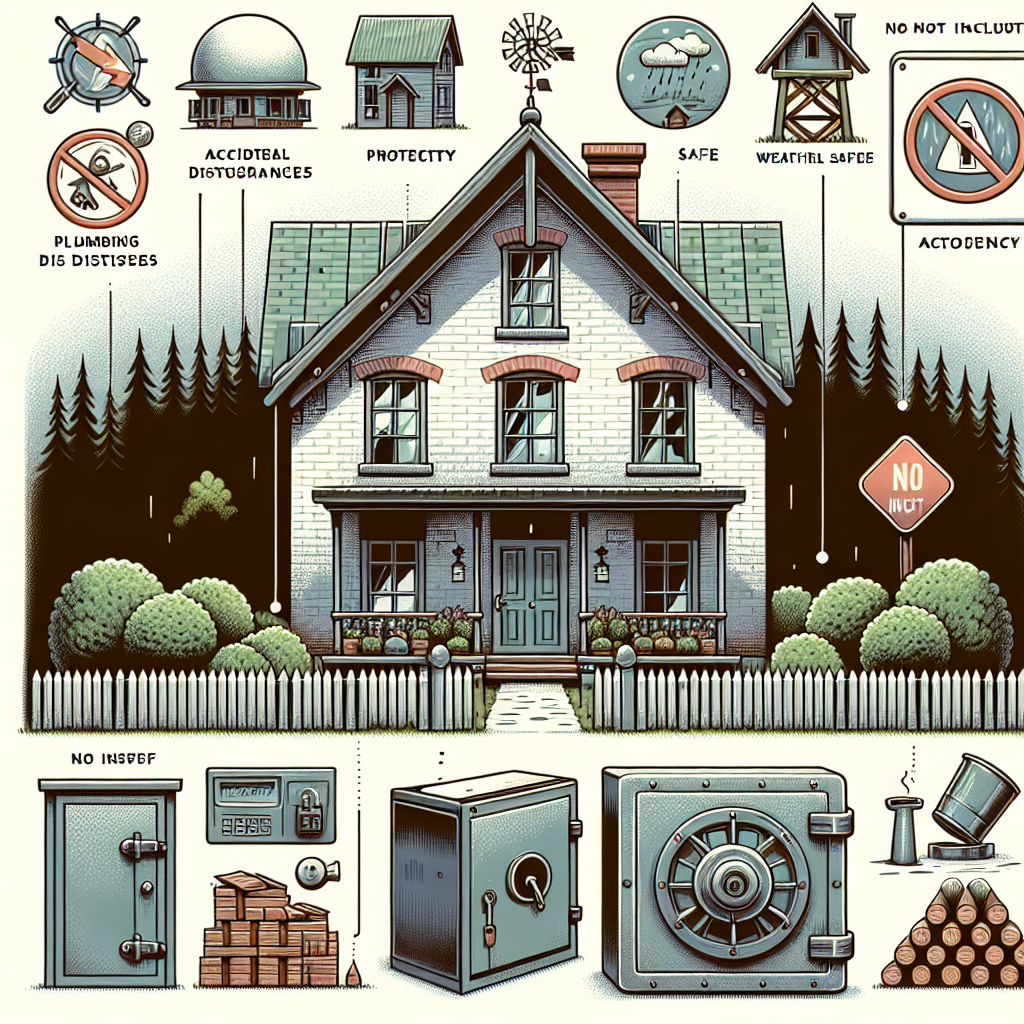Filed under Home Insurance on
Home Insurance Coverage Characteristics: What to Know

Your home is more than an address; it’s where your life happens. That’s why understanding home insurance coverage characteristics isn’t just a nice-to-have—it’s central to protecting your investment, your finances, and your peace of mind. Whether you’re renewing a policy or shopping for your first homeowners plan, this guide walks you through what matters, how policies really work, and the choices that can make or break your claim outcome.
The building blocks of homeowners coverage
At the heart of any policy are the foundational protections that define how your home and belongings are insured. Think of these as the core home insurance coverage characteristics that shape your day-to-day protection.
Standard coverage parts
- Dwelling (Coverage A): Pays to repair or rebuild the house itself—walls, roof, floors, built-in appliances—if a covered peril damages it.
- Other structures (Coverage B): Covers detached structures like fences, sheds, and garages, typically at 10% of Coverage A by default.
- Personal property (Coverage C): Protects your belongings. You choose either actual cash value (ACV) or replacement cost value (RCV). RCV is usually worth the added premium.
- Loss of use (Coverage D): Pays for additional living expenses (like temporary rent or meals) if a covered loss makes your home uninhabitable.
- Personal liability (Coverage E): Covers bodily injury and property damage you’re legally responsible for, on and off your property.
- Medical payments (Coverage F): No-fault coverage for minor injuries to guests on your property.
All-risk vs. named perils
Most modern policies insure the dwelling on an “open perils” basis (everything is covered unless excluded) while personal property is often “named perils” (only specific causes are covered). HO-5 forms typically extend open-peril protection to personal property too, which is a meaningful upgrade if you can secure it at a fair rate.
Common exclusions to know
- Flood (from rising water) and earthquake are almost always excluded—these are separate policies or endorsements.
- Wear and tear, mechanical breakdown, and maintenance issues are not insurable events.
- Neglect, intentional loss, and government action are excluded.
- Sewer or drain backup is typically excluded unless you add coverage.
Industry groups like the Insurance Information Institute note that wind and hail remain the most frequent causes of claims nationwide, while fire and lightning tend to be among the costliest. That difference between frequency and severity is one reason your deductible choice and loss settlement terms matter so much.
Policy forms and what they really mean
Among home insurance coverage characteristics, the policy “form” is foundational—it defines what’s covered and how broadly.
- HO-1 and HO-2: Basic and broad named-peril coverage, now less common.
- HO-3: The most common; open perils on the dwelling, named perils on belongings.
- HO-5: More comprehensive; often open perils on both dwelling and personal property plus higher default sublimits.
- HO-4: Renters insurance for personal property and liability.
- HO-6: Condo insurance, which coordinates with your association’s master policy.
- HO-8: For older homes where replacement cost values are tricky; often named perils and ACV.
If your insurer offers HO-5 at a competitive price, it’s worth a hard look. It’s not just a marketing label; it typically improves how your belongings are insured and can simplify claims when the cause of loss is unclear.
Key coverage characteristics to examine in any policy
When you compare quotes, align on the essentials. Many of the most consequential home insurance coverage characteristics hide in the fine print.
1) Insurance-to-value and loss settlement
- Replacement cost vs. actual cash value: ACV subtracts depreciation; RCV pays what it takes to replace new for old.
- Extended or guaranteed replacement cost: Extended (e.g., +25% or +50%) gives a buffer if building costs spike; “guaranteed” aims to rebuild regardless of limit (less common and pricier).
- Inflation guard: Automatically increases limits during the policy term to track materials and labor costs.
2) Deductibles and special deductibles
- Flat vs. percentage: A 2% deductible on a $500,000 dwelling is $10,000—make sure you’re comfortable with that out-of-pocket number.
- Wind/hail or named storm deductibles: Coastal and hail-prone states often have separate, higher deductibles for these perils.
3) Sublimits and special property categories
- Jewelry, watches, firearms, silverware, cash, and collectibles often have low theft or overall limits.
- Electronics and e-bikes may have unique caps or requirements.
- Scheduled personal property: “Schedule” high-value items for broader coverage and no deductible in many cases.
4) Endorsements that matter
- Water backup and sump overflow: Critical if your home has a basement or older plumbing.
- Service line coverage: Pays to repair underground lines you own (water, sewer) that most policies exclude.
- Ordinance or law: Helps pay for code upgrades required during rebuilding—often overlooked.
- Equipment breakdown: Covers sudden mechanical or electrical breakdown of HVAC and major systems.
- Cyber and identity fraud: Emerging add-ons as connected-home risks grow.
5) Occupancy and usage
- Short-term rentals: Some policies exclude or limit Airbnb/VRBO activity without specific endorsements.
- Home businesses: Liability or property coverage for business gear and visitors may require a rider.
These aren’t just technicalities. The right blend of limits, endorsements, and settlement terms can be the difference between a paid-in-full rebuild and a funding gap that delays recovery.
Trends reshaping the market right now
Insurers and homeowners are adapting to a changing risk landscape, and that evolution is shaping home insurance coverage characteristics in real time.
- Climate volatility: More frequent and severe storms and wildfires have driven higher catastrophe losses, influencing rates and underwriting appetite.
- Reinsurance pressure: Costlier reinsurance (insurance for insurers) pushes premiums higher and tightens guidelines.
- Inflation and labor shortages: Construction costs jumped in recent years; accurate replacement cost estimates are more important than ever.
- Underwriting innovations: Aerial roof scans, property data, and smart-home signals are increasingly part of eligibility and pricing.
- Market shifts: Some carriers are pausing new business in select regions; FAIR Plans may be a last-resort option for high-risk properties.
Industry reports from organizations like the National Association of Insurance Commissioners and analysis firms note that mitigation—upgraded roofs, defensible space in wildfire zones, water leak sensors—can meaningfully influence availability and price. Insurers are rewarding proactive risk reduction more consistently.
Right-sizing your dwelling limit
Getting Coverage A (dwelling) right is nonnegotiable. It should reflect what it would cost to rebuild your home today, not what you paid or what you owe on the mortgage. Several home insurance coverage characteristics influence this calculation.
- Use a reputable replacement cost estimator that accounts for materials, square footage, architectural details, local labor, and debris removal.
- Add inflation guard and consider extended replacement cost to buffer against surprise spikes.
- Consider ordinance or law coverage, especially for older homes that will need code upgrades.
- Review after renovations or major purchases—kitchen remodels and additions can move you out of compliance with your current limit.
- Ask about eligibility thresholds: Many policies require you to insure to at least 80% of replacement cost to get full RCV treatment on partial losses.
A quick way to stress-test your limit: Could you replace your roof, kitchen, and flooring if a severe storm and water damage hit at once? If the math feels tight, your limits probably are too.
Liability deserves more attention than it gets
Claims aren’t always about damaged property. Liability claims can upend finances—think dog bites, deck collapses, or a guest’s serious fall.
- Start at $300,000 and consider $500,000 for Coverage E if you have assets, savings, or high future income potential.
- Personal umbrella policies (usually $1–$5 million) are surprisingly affordable and extend your protection beyond homeowners and auto.
- Pools, trampolines, short-term rentals, and high foot traffic increase liability exposure—your agent needs to know about them.
- Watch for breed restrictions and animal liability exclusions if you have pets.
According to consumer research from claims and litigation analytics groups, social inflation and rising medical costs have elevated severe liability outcomes. Right-sizing limits is a cost-effective safeguard.
How claims really work (and how to avoid headaches)
When something goes wrong, process and paperwork determine speed and satisfaction as much as coverage terms do.
Before a loss
- Create a home inventory: Photos or video walkthroughs plus receipts for big-ticket items. Store backups in the cloud.
- Document upgrades: Keep permits and contractor invoices to support a higher replacement cost.
- Maintain the property: Insurers can deny claims tied to neglect or unresolved maintenance issues.
During a claim
- Mitigate damage immediately: Tarp the roof, shut off water, and hire emergency services as needed. Keep receipts.
- Understand depreciation and recoverable depreciation: With RCV, you may receive ACV first and the balance after you complete repairs.
- Use preferred vendors—carefully: Networks can speed up service, but you can choose your own contractor. Get multiple estimates for larger losses.
- Track everything: Communications, invoices, estimates, and timelines.
After settlement
- Reassess coverage: Adjust limits and endorsements based on what you learned.
- Consider mitigation upgrades: Impact-resistant roofing, water shutoff valves, or defensible space can reduce future losses and may earn discounts.
Special property categories and the fine print
Not all belongings are treated equally, and this is where home insurance coverage characteristics can surprise you at claim time.
- Jewelry and watches: Typical theft sublimits might be only $1,500–$5,000. Schedule high-value pieces.
- Artwork and collectibles: May need appraisals and specialized riders to cover market value.
- Musical instruments and camera gear: Professional use can change how items are covered.
- E-bikes and scooters: Check for motorized vehicle exclusions and consider endorsements.
- Home office equipment: Limits vary; business property often has a lower cap, especially away from the residence.
Scheduling treasured items typically broadens coverage to include mysterious disappearance and may remove the deductible. If it would break your heart or budget to replace it, schedule it.
Regional risks and supplemental policies
Location shapes your risk profile, and your policy should reflect those realities.
Flood
- Standard homeowners policies exclude flood. Consider a separate policy through the National Flood Insurance Program or private carriers.
- FEMA emphasizes that even an inch of water can cause tens of thousands in damage, and a significant share of flood claims occur outside high-risk zones.
Earthquake
- Available via standalone policies or endorsements in many states. Deductibles are usually a percentage of Coverage A.
- Secure heavy furniture and water heaters, and brace chimneys to reduce damage.
Hurricanes and wind
- Named storm or hurricane deductibles apply in coastal states; review triggers and percent levels.
- Roof shape and materials matter—hip roofs and impact-rated shingles can earn credits.
Wildfire
- Create defensible space, use ember-resistant vents, and upgrade to Class A roofing in high-risk zones.
- Some areas may require surplus lines carriers or FAIR Plan coverage; coordinate with a dwelling fire or wrap policy to fill gaps.
Hail and freeze
- Impact-resistant roofing and proper attic ventilation reduce hail and ice-dam losses.
- Smart water shutoff valves and pipe insulation help prevent freeze-related water damage.
Smart shopping and saving without sacrificing protection
Premiums have risen in many states, but you can trim costs while preserving the most important home insurance coverage characteristics.
- Bundle home and auto: Often the biggest discount.
- Raise deductibles thoughtfully: A higher wind/hail or all-perils deductible can save a lot—just keep an emergency fund.
- Mitigation discounts: Impact-rated roofs, monitored security, water shutoff devices, and wildfire hardening may cut premiums.
- Mind your roof: Age, material, and condition heavily influence eligibility and price.
- Credit and claims history: Many carriers use credit-based insurance scores and CLUE reports; avoid small claims that erase discounts.
- Annual coverage review: Update limits after renovations, major purchases, or local construction cost changes.
- Independent agents: They can shop multiple carriers and explain differences beyond price.
Condo and rental nuances
Condo (HO-6)
- Match your coverage to the association master policy (all-in vs. walls-in). Your responsibility could include drywall, cabinets, or more.
- Loss assessment coverage helps when the association assesses unit owners after a covered loss.
Renters (HO-4)
- Protects your belongings and liability; your landlord’s policy doesn’t cover your stuff.
- Loss of use is crucial if a fire or burst pipe displaces you.
Practical checklists
Annual policy tune-up
- Confirm dwelling replacement cost and apply inflation guard.
- Review endorsements: water backup, service line, ordinance or law.
- Check sublimits for jewelry, electronics, and specialty items; schedule where needed.
- Evaluate liability and consider an umbrella policy.
- Update inventory and receipts; store them offsite or in the cloud.
Questions to ask your agent
- Is my personal property covered at replacement cost or ACV?
- What is my wind/hail or named storm deductible, and how is it triggered?
- Do I have water backup, ordinance or law, and service line coverage?
- What are my sublimits for jewelry, electronics, and firearms?
- If I host short-term rentals, how is that covered?
Common pitfalls to avoid
- Underinsuring the dwelling: Leads to partial claim penalties and funding gaps.
- Skipping endorsements to save a few dollars: Water backup and ordinance or law are frequent difference-makers.
- Assuming “market value” equals “replacement cost”: Land value and market trends don’t rebuild houses—materials and labor do.
- Not disclosing material changes: Unreported roof replacements, business use, or rentals can jeopardize claims.
- Choosing the lowest premium blindly: The cheapest policy often has the highest long-term cost when a loss hits.
Expert perspective and where the market is headed
Analysts following insurance cycles point to three durable themes: risk-based pricing, data-driven underwriting, and resilience incentives. Reports from industry research organizations suggest carriers will continue rewarding mitigation (from smart water valves to wildfire hardening) and scrutinizing properties with aging roofs or elevated natural catastrophe exposure. Consumers who engage in proactive risk reduction and keep policies aligned with real rebuilding costs tend to see better availability and claim outcomes.
Pulling it all together
The best homeowners policy isn’t just the one with the lowest quote—it’s the one that will rebuild your life on your hardest day. By focusing on the right mix of limits, settlement terms, deductibles, endorsements, and liability protection, you can shape a policy that fits your home, your region, and your budget. Work with a knowledgeable agent, revisit your coverage annually, and invest in mitigation where it makes sense. Those steps will help ensure your coverage keeps pace with changing risks and costs.
If you remember nothing else, remember this: clarity beats complexity. Ask how your policy treats the specific events most likely where you live. Confirm how replacement cost is calculated. Check sublimits on items you care about. And align your plan with the home insurance coverage characteristics that truly determine how well you’ll recover after a loss.
Finally, if you’re unsure where to start, gather your current declarations page, make a quick inventory of big-ticket items, and schedule a 30-minute coverage review. A focused conversation now can save weeks of stress later—and potentially thousands of dollars when it counts.
Understanding these home insurance coverage characteristics—and tailoring them to your needs—puts you in control. That’s how you turn a policy from a stack of paper into a resilient financial plan for your home.





